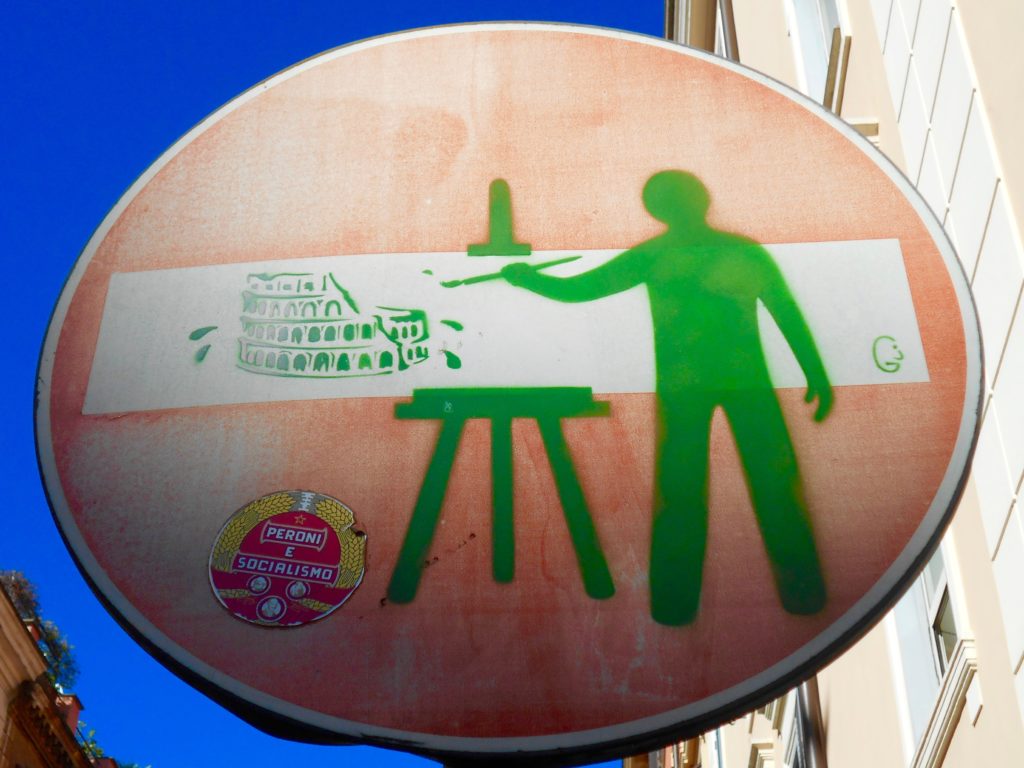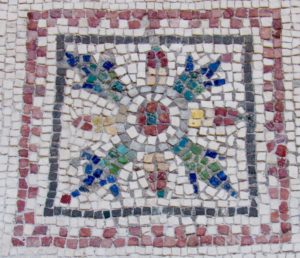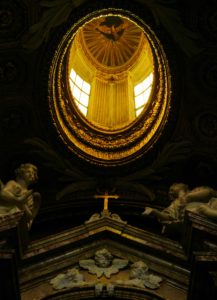PolychROME (2017)
for flute, clarinet, horn, accordion, percussion, 2 violins, viola, cello, and bass [14:00]
“During the day my eyes and head filled up with a quantity of brightness that my brain couldn’t digest, and so it worked overtime, while I was asleep, concocting hours of deranged and brilliant footage as a way of using up the wash and surge of surplus color and excess light.” — Geoff Dyer, “Decline and Fall”
 Rome is a saturated city, overflowing with ornate detail. Like the gaudy interiors of its Baroque churches, there is a visceral sensory overload, too much to take in. But from a perch up on the Janiculum, where I spent a year at the American Academy, distance collapses that clamor into languor. Spread out below, the city’s subtle color palette shifts slowly under its distinctive diffuse light.
Rome is a saturated city, overflowing with ornate detail. Like the gaudy interiors of its Baroque churches, there is a visceral sensory overload, too much to take in. But from a perch up on the Janiculum, where I spent a year at the American Academy, distance collapses that clamor into languor. Spread out below, the city’s subtle color palette shifts slowly under its distinctive diffuse light.
Today’s kaleidoscope however is only a fraction of Rome’s historical color. “The temples, monuments, and statues were originally painted. The color of classical Rome was not chalky white but electric blue, strawberry blond, sunshine yellow, a seven-year-old’s coloring book.” (Anthony Doerr) The idea of delving into the color spectrum brought to mind Gérard Grisey, for whom Rome played a transformative role; his journals mention wandering the gardens at Villa Médicis, brewing up plans for Périodes and Ensemble L’Itinéraire.
 PolychROME opens with the image of reinvigorating the faded, sun-struck stones of antiquity, rediscovering the vibrancy their eroded colors. There is a sonic parallel here, an attempt to delve inside “pitchless” sounds to uncover and amplify their hidden components. The ringing of timbales, springs coils, and cowbells have been orchestrated in the ensemble (sometimes with the aid of IRCAM’s Orchids) to create a microtonal halo that extends their resonance past its natural boundaries. At other points, the ensemble is reimagined as a large bank of resonant filters, oscillators that react to a solo line or percussion attacks.
PolychROME opens with the image of reinvigorating the faded, sun-struck stones of antiquity, rediscovering the vibrancy their eroded colors. There is a sonic parallel here, an attempt to delve inside “pitchless” sounds to uncover and amplify their hidden components. The ringing of timbales, springs coils, and cowbells have been orchestrated in the ensemble (sometimes with the aid of IRCAM’s Orchids) to create a microtonal halo that extends their resonance past its natural boundaries. At other points, the ensemble is reimagined as a large bank of resonant filters, oscillators that react to a solo line or percussion attacks.
 Throughout eight episodes, PolychROME embraces an unapologetically ambitious level of coloristic nuance: microtones, multiphonics, several types of mutes and preparations, polyrhythmic lattices. There are sunbeams and gold-leaf angels spilling out of high windows, busy geometric patterns of marble and colored glass in Cosmati mosaics, the screeches of neon-green parrots—an invasive species, imported from North Africa—whose cries punctuated work in my garden studio, and found their way into the fifth section of the piece.
Throughout eight episodes, PolychROME embraces an unapologetically ambitious level of coloristic nuance: microtones, multiphonics, several types of mutes and preparations, polyrhythmic lattices. There are sunbeams and gold-leaf angels spilling out of high windows, busy geometric patterns of marble and colored glass in Cosmati mosaics, the screeches of neon-green parrots—an invasive species, imported from North Africa—whose cries punctuated work in my garden studio, and found their way into the fifth section of the piece.

The ending of PolychROME follows the arc of Geoff Dyer’s story “Decline and Fall,” in which the vibrant city is gradually slowed to a state of paralysis by the stifling summer heat:
“Each day the city became hotter, emptier, quieter. The streets succumbed to a kind of eclipse: they looked, in bright daylight, as they did at night when all the shutters were down. It was August, ‘the month of stalled pendulums’ [Joseph Brodsky], and I too was stalled.”
In its final minutes, the lightness in the atmosphere begins to drag. Sonorities calcify; all forward motion evaporates. Everything ends up as spotlit and exposed as sunlight on hard stone. Like a cinematic fade to white, the piece dissolves into a blinding, unforgiving glare—the polar opposite of subtle shading, stark sound stripped of all artifice.